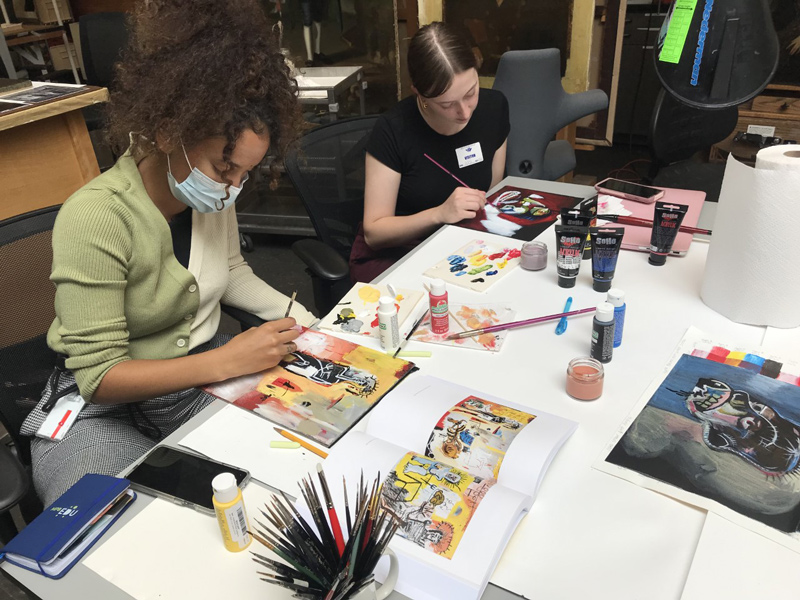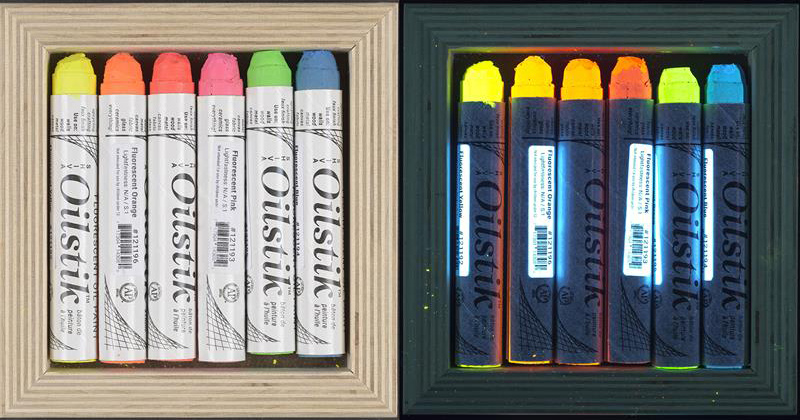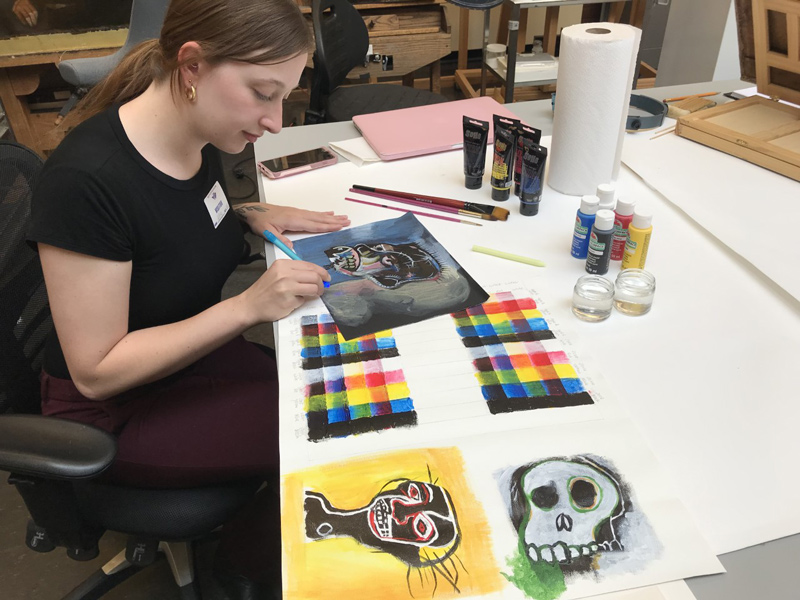


Experimenting with art, science
Photos by Joyce Hill Stoner July 18, 2022
Conservators use innovative Basquiat techniques to engage K-12 students
A team of alumni, faculty and students from the University of Delaware’s Department of Art Conservation has taken research on famed modern artist Jean-Michel Basquiat into new territory, using his innovative methods to teach K-12 students about ways in which art and science can come together.
Basquiat, an influential neo-expressionist, came from a graffiti background. He often used oil sticks — crayon-like cylinders made up of mineral wax and oil paint — that sometimes were visible in his paintings only under UV light.
Among the conservators who have found hidden inscriptions, symbols and complex imagery in his work are Emily MacDonald-Korth, who graduated from the Winterthur/University of Delaware Program in Art Conservation (WUDPAC) in 2011, and Kristin deGhetaldi, a 2008 WUDPAC graduate and a 2016 graduate of UD’s Preservation Studies Doctoral Program. They and 1979 WUDPAC alumna Christine Daulton, a conservator who has worked extensively on the paintings at the Andy Warhol Museum, have been collaborating with others in analyzing the chemical composition and aging properties of the oil sticks that Basquiat used.
Also working on the research are Joyce Hill Stoner, paintings conservator and Rosenberg Professor of Material Culture at UD; Brian Baade, UD assistant professor of art conservation and a 2006 WUDPAC alumnus; Kelsey Marino, a UD undergraduate alumna and pre-program intern; Katie Rovito and Magdalena Solano, both members of WUDPAC’S 2022 graduating class; and scientists at Winterthur Museum’s Science Research and Analysis Lab, where oil stick samples were analyzed.

Building on this research and supported by a grant from an anonymous private collector, the team of conservators has developed lesson plans and toolkits for use in classrooms with younger children and teens. Art teachers in Delaware and Florida were the first to use the toolkits to show their students how science can tell us more about an artist’s work, history and creative process.
“Our idea is that if students can do an art project where they use oil sticks to add hidden images [that are then revealed by black light], that becomes a springboard to talk about Basquiat and other artists,” deGhetaldi said.
Basquiat’s youth — he was only 27 when he died in 1988 — and unconventional techniques are characteristics to which teenage students can relate, the conservators say. And classroom discussions about chemical analysis and the physics of light can show the intersection of art and science.
“I like the idea of using art to teach kids about science and about how the two can work together, as they do in art conservation,” said Marino, who as a conservation technician with the project has created the toolkits and is reaching out to K-12 schools about their interest. “A lot of people in this field weren’t introduced to it formally; we just kind of discovered it as we took college courses. We also want to give the kids a sense of Basquiat and who he was and how he worked.”

To date, schools in Pennsylvania, Florida and Delaware have been involved. The project provides teachers with a lesson plan and other resources, including oil sticks and a black light. A recent session was held in Latrobe, Pennsylvania, at the end of May, with Daulton helping in that Pittsburgh-area school.
At the Campus Community School, a charter elementary school in Dover, Delaware, art teacher Jennifer Boland used the toolkit’s resources in a lesson with her seventh graders. Boland, also an art history professor at Delaware Technical Community College, was already a fan of Basquiat’s work when she heard about the K-12 outreach and jumped at the chance to share it with her students.
“They [the conservators] shared this amazing research they had done, with the history of the images, and a great PowerPoint they created to explain it,” Boland said. “As classroom teachers, we don’t always have time to do this kind of presentation, so it was wonderful to be able to use the one they developed.”
Over three days, her students learned about Basquiat’s work and about how conservators use science to study art. They created their own paintings, with a theme of “creatures,” and used oil sticks to hide images that could be revealed under black light.
The students were creative and enthusiastic about the project, Boland said. She described a painting of a dinosaur-like creature with staring eyes; black light showed tears behind those eyes. Another creature featured alarmingly big teeth; under the black light, viewers could see tiny creatures he had eaten.
“It was a good chance to combine science and art,” Boland said. “And the kids were really engaged. Weeks later, they were still talking to me every day about this lesson.”
Contact Us
Have a UDaily story idea?
Contact us at ocm@udel.edu
Members of the press
Contact us at 302-831-NEWS or visit the Media Relations website

